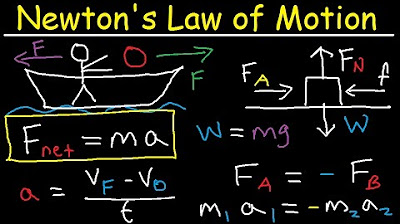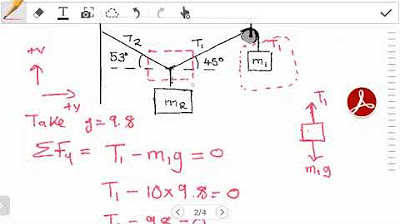Newton's Third Law of Motion Grade 11 and 12 Physics
TLDRThis educational video delves into Newton's third law of motion, clarifying its concept and misconceptions. It emphasizes that for every action, there is an equal and opposite reaction, acting on two different objects simultaneously. The video uses examples to illustrate how these forces do not cancel each other out as they act on distinct objects. It also addresses common mistakes in applying the law, such as confusing it with balanced forces, and encourages understanding the law's application in various scenarios, including gravitational and frictional forces.
Takeaways
- 📜 Newton's third law of motion states that for every action, there is an equal and opposite reaction.
- 🔍 The law involves action-reaction pairs where forces act on different objects, not balancing each other out.
- 🤔 Understanding the concept is more important than calculations for Newton's third law, as it's definition-based.
- 👉 Action and reaction forces are equal in magnitude, opposite in direction, and occur simultaneously.
- 🚫 Common misconception: normal force and weight are not an example of Newton's third law because they act on the same object.
- 🌍 Weight is the force exerted by the Earth on an object, and its action-reaction pair is the force exerted by the object on the Earth.
- 🛒 When a woman pushes a trolley, the force she exerts on the trolley (action) is met with an equal and opposite force exerted by the trolley on her (reaction).
- 💡 The difference in motion between two objects in an action-reaction pair is due to their differing masses and resulting accelerations.
- 📚 In exam questions, it's crucial to identify the correct action-reaction pair and not confuse them with other force concepts.
- ❌ Balanced forces are not applicable to Newton's third law as the forces, although equal and opposite, act on different objects and do not cancel each other out.
- 🎓 The video aims to clarify misconceptions and provide a deeper understanding of Newton's third law to improve performance in physics exams.
Q & A
What is Newton's third law of motion?
-Newton's third law of motion states that for every action, there is an equal and opposite reaction. This means that when object A exerts a force on object B, object B simultaneously exerts an oppositely directed force of equal magnitude on object A.
How does Newton's third law differ from the first two laws?
-Unlike Newton's first and second laws, which may involve calculations, Newton's third law is more conceptual. It focuses on understanding the relationship between action and reaction forces acting on two different objects simultaneously.
What are the properties of action-reaction pairs according to Newton's third law?
-The properties of action-reaction pairs are that the forces always act in pairs, occur simultaneously, and act on different objects. They are equal in magnitude and opposite in direction but do not balance each other out because they act on separate objects.
Why do action and reaction forces not cancel each other out?
-Action and reaction forces do not cancel each other out because they act on different objects. Cancellation would only occur if the forces were acting on the same object.
Can you provide an example of a misconception regarding Newton's third law?
-A common misconception is confusing the normal force and the weight of an object as an example of Newton's third law. However, both forces act on the same object (the object itself), which is not the case for action-reaction pairs according to Newton's third law.
What is the relationship between the weight of an object and the normal force?
-The weight of an object is the force exerted by the Earth on the object, while the normal force is the force exerted by the surface (like a table) on the object. They act on the same object and are not an example of action-reaction pairs from Newton's third law.
How does the mass of objects influence the acceleration according to Newton's third law?
-According to Newton's third law, if two objects exert equal and opposite forces on each other, the object with a larger mass will experience a smaller acceleration, while the object with a smaller mass will experience a larger acceleration.
Why doesn't the Earth move towards a falling object despite the action-reaction force?
-The Earth does not visibly move towards a falling object because the Earth has a very large mass compared to the object. The acceleration it experiences due to the action-reaction force is so small that it is not noticeable.
What is the correct way to identify an action-reaction pair in a physics problem?
-To identify an action-reaction pair, you must look for two forces that are equal in magnitude, opposite in direction, and acting simultaneously on two different objects. These forces are not considered balanced forces and are a direct result of Newton's third law of motion.
Which statement does not apply to Newton's third law of motion?
-The statement that does not apply to Newton's third law is 'the forces are called balanced forces.' Newton's third law describes that the forces are equal in magnitude and opposite in direction but acting on different objects, and they are not considered balanced forces.
Outlines
📚 Introduction to Newton's Third Law
This paragraph introduces the topic of Newton's third law of motion, emphasizing its conceptual nature as opposed to the more calculation-heavy first and second laws. It outlines the definition of the law, which states that for every action, there is an equal and opposite reaction. The explanation includes a practical example of a finger pushing against a wall, illustrating how forces act in pairs, simultaneously, and on different objects. The paragraph also clarifies common misconceptions about action-reaction pairs, stressing that these forces do not cancel each other out because they act on different objects.
🧐 Misunderstandings about Action and Reaction Pairs
This section addresses common errors in understanding Newton's third law, particularly the confusion between action-reaction pairs and other types of forces such as normal force. It explains that the weight of an object (the force exerted by Earth) and the normal force (the force exerted by a surface on the object) are not an example of action-reaction pairs because they act on the same object. The paragraph further clarifies the concept by discussing the force of the Earth on a book and its corresponding action-reaction pair, as well as the force of a woman pushing a trolley and the reaction force exerted by the trolley on the woman. It emphasizes the importance of recognizing that action and reaction forces are equal in magnitude and opposite in direction but act on different objects.
🌍 The Pen and the Earth: A Thought-Provoking Example
This paragraph delves into a thought experiment involving a pen falling from a desk and the forces at play. It explains how the Earth exerts a force on the pen (weight), and according to Newton's third law, the pen exerts an equal and opposite force on the Earth. The discussion highlights the difference in mass between the pen and the Earth, which results in vastly different accelerations despite the forces being equal in magnitude. The section clarifies why the pen falls towards the Earth and the Earth does not visibly move towards the pen, attributing this to the Earth's immense mass and the pen's tiny mass, respectively.
✅ Understanding Newton's Third Law through Multiple Choice Questions
The final paragraph focuses on reinforcing the understanding of Newton's third law through multiple-choice questions. It corrects common misconceptions and tests the viewer's grasp of the law's principles. The questions cover the characteristics of action-reaction pairs, such as the requirement for forces to be equal in magnitude and opposite in direction, and the fact that these forces act on different objects. The paragraph concludes with a summary of the key points and encourages further exploration of Newton's laws in future videos.
Mindmap
Keywords
💡Newton's Third Law of Motion
💡Action-Reaction Pairs
💡Force
💡Magnitude
💡Direction
💡Exam Guidelines
💡Physics
💡Weight
💡Frictional Force
💡Balanced Forces
Highlights
Newton's third law of motion is introduced as a concept rather than a calculation-based law.
The law states that for every action, there is an equal and opposite reaction acting on different objects.
Action and reaction forces occur simultaneously and are of equal magnitude but opposite direction.
The properties of action-reaction pairs include always occurring in pairs, acting simultaneously, and affecting different objects.
People often misunderstand by thinking action and reaction forces cancel each other out, but they only cancel if acting on the same object.
The weight of an object (the force exerted by Earth) and the normal force are not an example of Newton's third law because they act on the same object.
The correct action-reaction pair for the normal force would be the force of the object on the surface it's in contact with.
Weight is the force exerted by the Earth on an object, and its action-reaction pair is the force of the object on the Earth.
Understanding the difference between the weight of an object and the normal force is crucial for grasping Newton's third law.
The video provides examples to clarify common misconceptions about Newton's third law, such as the interaction between a book and a table.
In a supermarket, when a woman pushes a trolley, the trolley pushes back with an equal and opposite force.
The pen falling off a desk example illustrates that while the Earth pulls the pen down, the pen also pulls the Earth up, albeit with negligible effect due to Earth's mass.
The video emphasizes the importance of understanding that action and reaction forces act on different objects and do not balance each other out.
A multiple-choice question is used to test the understanding that the Earth's large mass results in a small acceleration towards the pen, unlike the pen's significant acceleration towards the Earth.
The video concludes with a quiz question about which statement does not apply to Newton's third law, highlighting the understanding of action-reaction pairs.
The importance of distinguishing between balanced forces and action-reaction pairs is stressed, as they are not the same.
The video aims to help viewers level up their understanding of physics, particularly Newton's laws of motion.
Transcripts
Browse More Related Video
5.0 / 5 (0 votes)
Thanks for rating:





